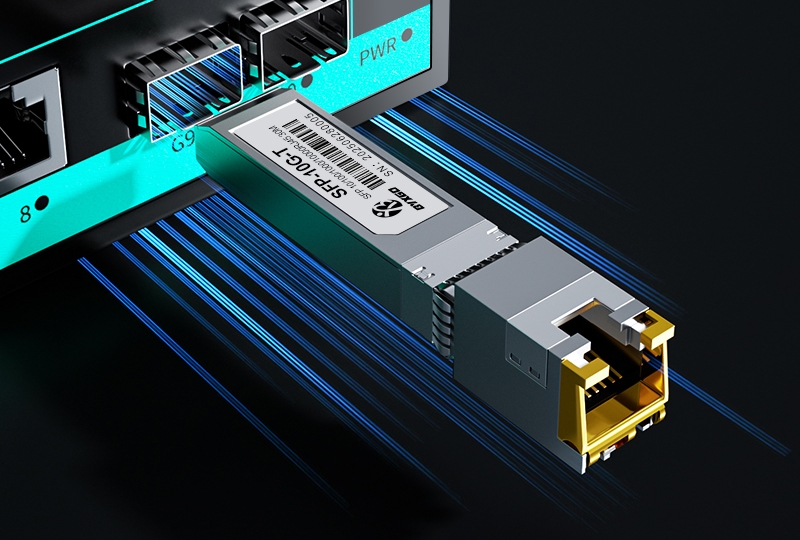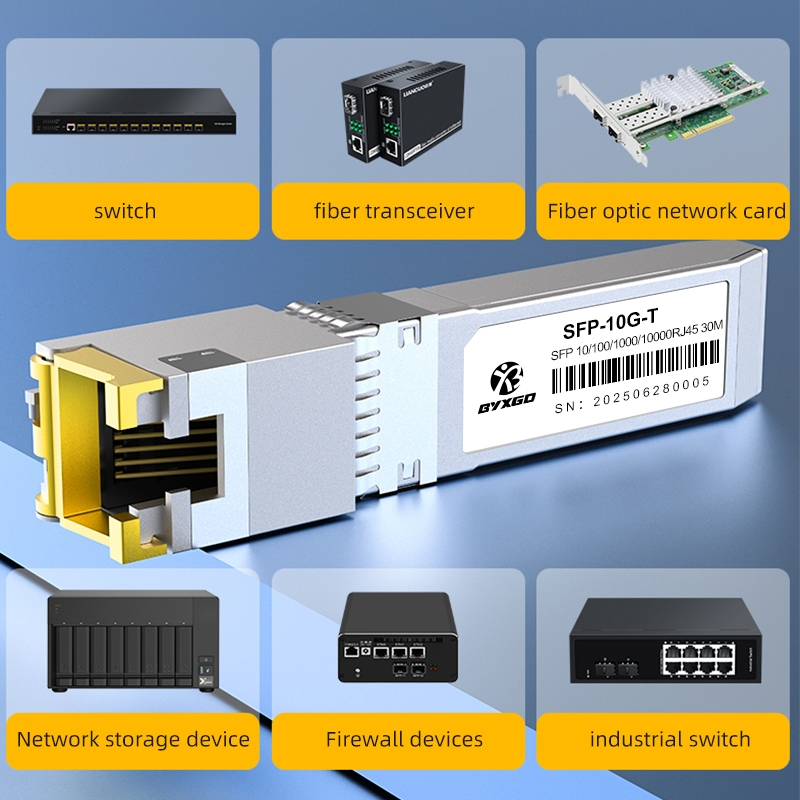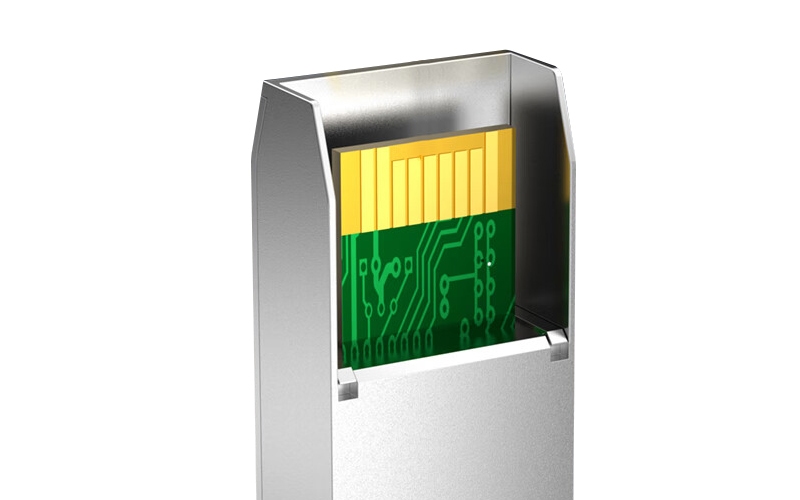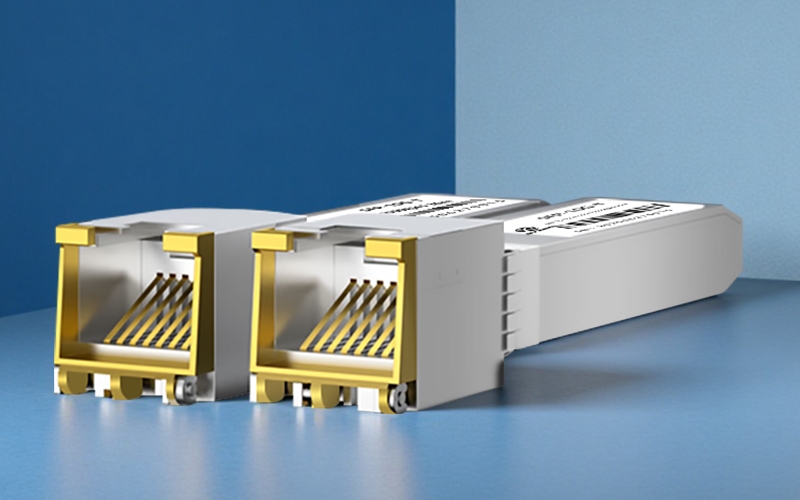Ultimate Guide to SFP+ to RJ45 Adapter: Seamlessly Connecting Fiber and Copper Networks

Incorporating 10G fiber networks into current copper infrastructure may seem daunting. The SFP+ to RJ45 adapter is a useful intermediary, interconnecting the two different technologies. By learning the adapter’s operation, determining the appropriate adapter model, and installing and troubleshooting the adapter, network professionals will have the ability to optimize performance in heterogeneous environments. This resource provides an overview of the adapter’s fundamentals, compatibility, performance, price, and future possibilities to create a foundation for next-level connectivity for the network professional.
What Is an SFP+ to RJ45 Adapter and How Does It Connect to 10GBase-T Networks?
Establishing a connection between copper-based Ethernet and fiber-optic networks has always required clever solutions. To help with this, an SFP+ to RJ45 adapter provides a way to achieve interoperability between SFP+ fiber ports and legacy copper cabling. This is extremely useful if you want to keep your existing cabling investment but still take advantage of faster network speeds, specifically 10G. To better appreciate the SFP+ to RJ45 adapter, it is important to understand what it is, how its standards work, and why copper cabling will still play an important role in many networks in the future.
What Is the Core Function and Technology Behind the Adapter?
An SFP+ to RJ45 adapter mainly serves as a signal converter. SFP+ ports send high-speed electrical signals that the adapter must convert into forms that RJ45 Ethernet connections can use. These adapters are compatible with the 10GBase-T standard, which transmits data over twisted-pair copper cables—most often, Category 6a or Category 7 cables.
This adapter modulates and demodulates the data flow, connecting the SFP+ fiber-based module to the RJ45 copper module. Adapters of this kind support data speeds from 1 Gbps up to 10 Gbps, and some are backward compatible to also support 2.5 Gbps and 5 Gbps rates.
While this allows for flexibility, the physical properties of copper introduce distance limitations. Typically, the maximum distance for 10GBase-T transmissions is approximately 30 meters with Category 6a cables, extending up to 100 meters with higher-tier Category 7 cables. Also, copper-based adapters on an SFP+ require more power and generate more heat than optical adapters, leading certain network designs to account for heat loads and power budgets.

Why Is Copper Cabling Still Vital in Networks?
Even with the increasing acceptance of fiber as a long-haul and backbone connection, copper cabling still has long-term benefits for shorter runs and enterprise environments. First and foremost is cost—copper cables and RJ45 ports will always be cheaper than fiber.
Then there is deployment ease, which definitely favors copper. Less specialized labor is needed for installation, which allows organizations to increase speeds without having to re-cable large sections or heavily disrupt an existing layout. Therefore, investing in copper infrastructure protects value and limits operational overhead.
Another factor is compatibility; older switches and network devices still use RJ45 ports. Most SFP+ to RJ45 adapters allow an organization to keep its older equipment and seamlessly transition from copper to fiber.
Copper also allows for Power over Ethernet (PoE), which provides power to devices like IP cameras and phones without additional power wiring. In addition to noise resistance and reliability in pervasive data centers, it is easy to see why copper still matters, even as fiber continues to emerge.
How to Choose the Best SFP+ to RJ45 Adapter and Ensure Network Compatibility?
Selecting an SFP+ to RJ45 adapter requires examining a few factors, weighing speed capability, compatibility, power consumption, heat production, and cost. If you understand these areas before purchase, it will make executing the projects easier and will reduce the displeasure that comes from fixing issues after construction.
What Are the Key Differences Between Leading SFP+ to RJ45 Adapters? — Exclusive Comparison
Adapters can vary significantly across manufacturers and models, which can affect performance and reliability in networks:
- Multi-speed support: Quality adapters will provide a seamless experience at 1, 2.5, 5, and 10 Gbps speeds and can accommodate different types of environments.
- Cable length capability: Higher-end adapters will have no problems maintaining 10G speeds at 30 meters on Cat6a cables and 100 meters on Cat7 cables. Adapters in the lower end may struggle with speed at their specified limit.
- Energy efficient: Copper-based adapters generally use more power than fiber, but higher-end adapters may utilize designs that incorporate heat sinks and ventilation for better thermal profiles.
- Vendor compatibility: Certified solutions will have no problems with interoperability with most major network switches and servers. Generic modules, however, can often lead to link negotiation failures which take diligence to troubleshoot.
- Thermal management: Quality adapters will help mitigate the potential for overheating in dense rack environments either by hardware or firmware.
Why Do Experts Recommend Certain Adapters? — Industry Insights
Network architects advocate for the implementation of adapters that balance performance stabilization and realistic energy use. Seasoned engineers emphasize the need to manage temperature and reduce heat accumulation in order to avoid failure cascades in closely packed configurations.
Procurement professionals emphasize the significance of a vendor’s certification. The modules that a vendor certifies have been tested in rigorous interoperability tests, thus lowering the risk of network outages due to hardware incompatibility.
Experts advocate against using cheap generic adapters. While these adapters may save up-front costs, it is the hidden costs associated with downtime and troubleshooting that become apparent and much more expensive.

How Can You Overcome Compatibility Challenges?
Compatibility issues can arise for many reasons, but most often they are caused by firmware differences, old switch software, or challenges during speed negotiations (or a mix of those).
Two recommendations here:
- Check for vendor compatibility with existing network equipment before anything is purchased.
- Keep firmware and drivers updated on the devices.
While planning tests in a test environment before deployment is useful, monitoring link stability in a controlled way after installation is most useful. Taking structured validation steps along with continuing firmware management reduces the potential for downtime from any adapter incompatibilities.
How to Choose the Right Adapter in Complex, Multi-Vendor Environments?
In multi-supplier environments, the selection process for adapters becomes more complex—performance consistency, interoperability across vendors, and ease of maintenance take center stage.
When using certified adapters that comply with universal standards, the risk of incompatible equipment choice is reduced. If your equipment vendors provide product compatibility matrices that cover a variety of integration options, there is greater exposure to compatibility with the equipment that supplier offers.
Beyond specifications or compatibility matrices, consider the level of support available, frequency of firmware updates, and the reputation of the supplier.
In a growing number of networks that are increasingly software-defined, adapters need to be compatible with dynamic networks and management, orchestration tools, which requires innovative monitoring capabilities as well as automation-ready interfaces for documentation. The strategic nature of the selection process actively avoids reduced network performance and costly troubleshooting, especially if you are utilizing hybrid cloud and edge deployment options with a diverse and varied hardware ecosystem.
How to Deploy, Compare Performance, and Troubleshoot SFP+ to RJ45 Adapters?
Deployment of SFP+ to RJ45 adapters involves navigating performance expectations and troubleshooting potential challenges to ensure seamless operation.
What Performance Trade-offs Exist Between SFP+ Fiber Modules and RJ45 Adapters?
Fiber modules are capable of ultra-low latency and better signal fidelity over kilometer intervals, making fiber an ideal medium for backbone infrastructure with applications sensitive to latency.
RJ45 adapters, on the other hand, run over copper cabling, which is limited to roughly 100 meters, use more power, produce more heat—requiring careful thermal planning—and come with challenges when using copper over distances, such as signal attenuation and electromagnetic interference, which can result in throughput problems.
That said, RJ45 adapters have the added benefit of leveraging existing copper infrastructure, and they have the ability to support multi-speed capability from 1 Gbps to 10 Gbps, which is necessary for certain use cases.

How Did One Company Successfully Deploy SFP+ to RJ45 Adapters in a Hybrid Network?
A mid-sized company wanted to go from 1G copper networking to 10G speeds without replacing all of the cable. The solution was to use SFP+ to RJ45 adapters to connect new fiber optic backbones to old copper devices and enhance the infrastructure.
The user initially struggled with compatibility issues and found themselves concerned with additional power draw, and in areas where switches were high-density, actively limited usage to avoid outages. The company found the right vendor after their first attempt and worked to deploy in stages to avoid excessive downtime.
The company improved network throughput tremendously, reducing its bottlenecks by more than 30%, and with error rates stabilizing, the process was able to demonstrate the benefit of deploying adapters and how they allowed for a hybrid upgrade without changing the entire Cat5/6 infrastructure.
What Are Common Issues and How Can You Troubleshoot Them Using CLI?
Intermittent link dropouts, overheating, and speed negotiation failures occur when problems are present for the adapter.
CLI commands such as show interfaces and show transceiver are useful to check the state of ports and health metrics along with error counts. Temperature alerts can help flag components that could suffer a thermal shutdown.
Resolving speed negotiation conflicts usually involves adjusting port speed and duplex or running updates for device firmware. Once suspect areas are identified, checking cables and isolating suspect ports can limit the scope of troubleshooting.
Vendor-specific commands aside, pertinent diagnostics will include:
- Confirming interface status and error counts
- Accessing transceiver diagnostics
- Clearing out all counters and logs
Proactive monitoring coupled with regular and timely maintenance builds resiliency and reliability into the network.
What’s the Future of SFP+ to RJ45 Adapters and How to Make a Smart Investment?
Networking environments are constantly changing, which raises interesting questions about what connection methods are best. Even though SFP+ to RJ45 adapters are essential as economical ways to connect fiber to copper, they need to be compared with other, often superior, options like media converters, to determine the best ROI.
How Do SFP+ to RJ45 Adapters Compare With Media Converters?
SFP+ to RJ45 adapters plug right into the SFP+ ports of devices straight away for quick deployment with little additional cabling. They are a simple-to-deploy plug-and-play device that streamlines network topologies and minimizes cabling congestion, but of course, you will still only be able to deploy these in systems where all devices are compatible.
Media converters are stand-alone devices that convert between fiber and copper ports, but they need to be powered separately for each conversion, and deployment may therefore be more complex. Media converters are well-suited for environments where there will be many vendors, or protocols may not align, but incur additional physical and operational complexity.
In the end, the choice is yours, and it all comes down to deployment scale, budgetary concerns, and architecture requirements. Adapters are generally geared towards homogeneous environments, while media converters will be more suited to heterogeneous cases or situations requiring bridging.
Why Does Cost Matter and What Is the ROI for Using These Adapters?
Cost considerations can drive network upgrades. Copper SFP+ to RJ45 adapters offer the strongest return on investment since they leverage the existing copper infrastructure and bypass (very costly) recabling with fiber back in the wiring pathway. They reduce your capital expenditure while speeding up your deployments.
The pricing of adapters is dictated by brand, certification, and other included features, with the goal of minimizing downtime risk from untested adapters, thus protecting your investment.
The value is realized not only in network performance improvements but also in lower maintenance costs. Deploying adapters where you already have copper drops enables you to utilize the 10G speeds in a budget-friendly manner and will be very attractive for deployments where costs are impactful.

What Are Emerging Market Trends and Technologies Impacting SFP+ to RJ45 Adapters?
There are a number of technology trends that will likely affect the market for SFP+ to RJ45 adapters going forward:
- FASTER ETHERNET STANDARDS: Ongoing attempts to advance to 40G and 100G Ethernet, including the new 100GBase-T standards related to copper interfaces, may potentially affect the future of 10G adapters. Many existing installations will continue to be 10G for years to come; therefore, the demand for adapters will still be relevant.
- SOFTWARE-DEFINED NETWORKING (SDN): Greater levels of automation occurring in networking will dictate future interfaces to adapt. Adapters with increased telemetry and programmable capabilities may be possible with SDN architectures.
- Alternative Copper Cabling: Improvements in cable materials and shielding may increase the distance and performance of copper cabling, and consequently indirectly improve the RJ45 adapters.
- Consolidation: As manufacturers consolidate hardware, there will be more adapters that support many vendors’ SFP+ interfaces.
- Increased Energy Efficiency Guidelines: As demands for greener IT increase, lower-power adapter versions may be developed.
Awareness of these trends will give organizations better confidence in their investments as the networking world continues its evolution and adaptation to new opportunities, without the transition creating chaos.
Conclusion
SFP+ to RJ45 adapters function as crucial linkages within the spectrum between the fiber and copper networks. Success in installation requires an understanding of specifications, ensuring compatible use, and balancing the needs of performance versus price. Be sure to select adapters that match the required speed and cable distance, have vendor certification, and are designed with heat dissipation in mind.
Updating your firmware on a regular basis and monitoring the network closely can provide stability over the long haul. You should take note of the trade-offs that fiber has against copper and choose according to your network’s requirements. Making a proper installation decision and maintaining it will result in steady uptime and longevity of hardware.
By following this guidance, you will be able to locate affordable and reliable upgrades to provide a strong link between high-speed fiber connections and legacy connections as an alternative to modern performance expectations.
Reference Sources
- Fern Network – What is an SFP+ to RJ45 Converter? — Blog describing the function and features of SFP+ to RJ45 converters.
- Small Form-factor Pluggable (SFP) – Wikipedia –Detailed overview of SFP and SFP+ modules, their specifications, and applications including usage in Ethernet and fibre optic networking.
